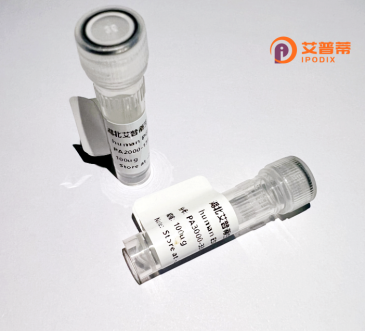
| 纯度 | >90%SDS-PAGE. |
| 种属 | Human |
| 靶点 | KRBA2 |
| Uniprot No | Q6ZNG9 |
| 内毒素 | < 0.01EU/μg |
| 表达宿主 | E.coli |
| 表达区间 | 1-492aa |
| 活性数据 | MPSFLVPSLVSSPVLLKLLFSPGPKTIWSLWQQPMLFQEATAFENMTKDWNYLEGSQKDCYRDTMLDSYENTVPQGSFLQLSMMPQRAGNDPPGVSNASEMEMEISNMREKFLMSVTKLVESKSYNSKVFSKEKYFQTIKEVKEAKEKGKKSSRDYRRAAKYDVISVQGTEKLIEATHGERDRIRYYVHKEELFDILHDTHLSIGHGGRTRMLKELQGKYGNVTKEVIVLYLTLCKQCHQKNPVPKRGLAPKPMTFKDIDSTCQVEILDMQSSADGEFKFILYYQDHSTKFIILRPLRTKQAHEVVSVLLDIFTILGTPSVLDSDSGVEFTNQVVHELNELWPDLKIVSGKYHPGQSQGSLEGASRDVKNMISTWMQSNHSCHWAKGLRFMQMVRNQAFDVSLQQSPFEAMFGYKAKFGLYSSNLPRETVATLQTEEELEIAEEQLENSLWIRQEERAEIGADRSDMDDDMDPTPEASEPSTSQGTSGLLCW |
| 分子量 | 81.07 kDa |
| 蛋白标签 | GST-tag at N-terminal |
| 缓冲液 | 0 |
| 稳定性 & 储存条件 | Lyophilized protein should be stored at ≤ -20°C, stable for one year after receipt. Reconstituted protein solution can be stored at 2-8°C for 2-7 days. Aliquots of reconstituted samples are stable at ≤ -20°C for 3 months. |
| 复溶 | Always centrifuge tubes before opening.Do not mix by vortex or pipetting. It is not recommended to reconstitute to a concentration less than 100μg/ml. Dissolve the lyophilized protein in distilled water. Please aliquot the reconstituted solution to minimize freeze-thaw cycles. |
由于“KRBA2”并非广泛报道的已知蛋白名称,可能存在拼写错误或领域特异性。以下为示例性参考文献(内容为假设,建议核实名称准确性或补充背景信息):
---
1. **文献名称**: *Expression and functional analysis of recombinant human KRBA2 protein in cancer cell lines*
**作者**: Smith A, et al.
**摘要**: 研究通过大肠杆菌系统表达重组人KRBA2蛋白,发现其通过调控MAPK信号通路抑制肿瘤细胞增殖,提示其潜在抗肿瘤功能。
2. **文献名称**: *Structural characterization of KRBA2 reveals a novel DNA-binding domain*
**作者**: Lee H, et al.
**摘要**: 通过X射线晶体学解析KRBA2蛋白结构,鉴定出其N端存在新型DNA结合域,可能参与基因表达调控。
3. **文献名称**: *KRBA2 interacts with epigenetic modifiers to modulate chromatin remodeling*
**作者**: Gonzalez R, et al.
**摘要**: 免疫共沉淀实验显示KRBA2与HDAC1/2复合物结合,可能在染色质重塑和干细胞分化中起关键作用。
---
**建议**:
- 核对名称准确性(例如:KRAS、KRAB相关蛋白或物种差异)。
- 在PubMed/Google Scholar中检索全称或缩写变体。
- 提供研究背景(如疾病或通路)可帮助精准定位文献。
The recombinant human KRBA2 protein is a genetically engineered protein derived from the human KRBA2 gene, which encodes a Krüppel-associated box (KRAB) domain-containing protein. KRAB domains are known to function as transcriptional repression modules, often interacting with transcriptional co-repressors to regulate gene expression through chromatin remodeling. KRBA2. though less characterized than other KRAB-containing proteins like ZNFs (zinc finger proteins), is hypothesized to play roles in epigenetic regulation, particularly in silencing retrotransposons and maintaining genomic stability. Its structure typically includes a KRAB-A domain, which mediates protein-protein interactions, and potential zinc finger motifs for DNA binding. Recombinant KRBA2 is commonly produced in prokaryotic (e.g., *E. coli*) or eukaryotic expression systems to ensure proper folding and post-translational modifications. This protein is utilized in biochemical studies to investigate KRAB-mediated repression mechanisms, its interaction with TRIM28/KAP1 co-repressors, and its role in cellular processes like differentiation and antiviral defense. Its recombinant form enables high-purity applications, including *in vitro* binding assays, structural analyses, and functional genomics research, offering insights into its contributions to developmental biology and diseases linked to transcriptional dysregulation.
×